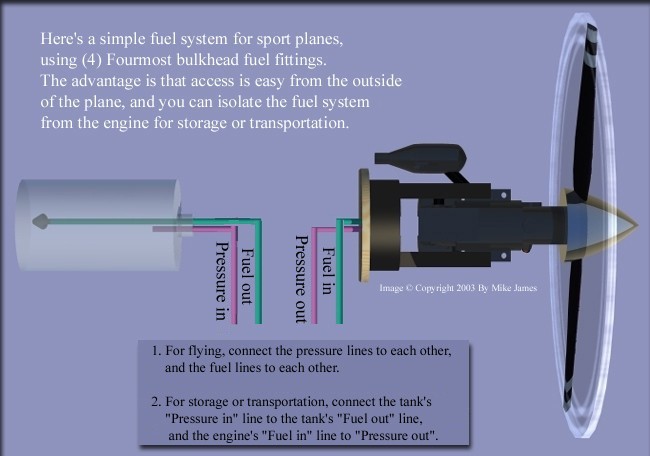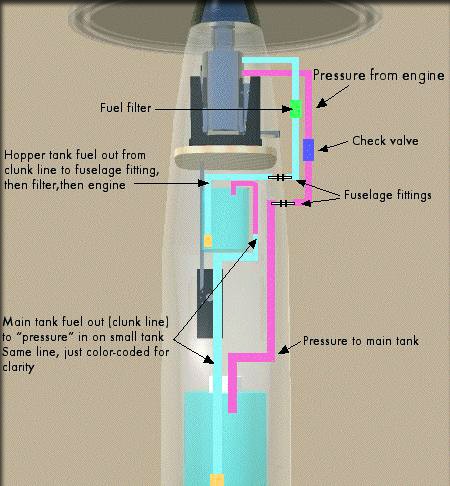Fuel Tank Plumbing
Here are a couple of alternatives for setting up your fuel system. The first method is something I use on simple "sport" planes, where scale appearance isn't important. The benefit is that you can store the plane with fuel in the tank, hanging at any angle, without worries of leaks.

If you use a pressure system, (either a pumped engine, or a separate fuel pump) here's a method (below) that will work, and it also allows you to place the main tank on the CG. (important for aerobatic precision)

Top view of CG-mounted main tank with small tank near engine (muffler system omitted for clarity)
If you want to minimize trim changes during a flight, caused by fuel consumption, one way to do it is to place the main tank on the CG, and use a small (2 oz.) tank near the engine. This keeps the small tank full and at constant pressure, and keeps the CG from moving much during flight.
When you fuel the aircraft, first disconnect the pressure line, aft of the check valve, and release any remaining tank pressure. If you don't do this first, you may squirt fuel all over yourself! Then fill the tanks by inserting your feed into the fuel line to the small tank, aft of the fuel filter. (This keeps you from flushing filter "crap" into the tank.) When full, the small tank will "overflow" into the main tank through it's clunk line, and overflow from the main tank's pressure line. Simple and effective.
With any pressure system:
1. If you use an engine that puts a LOT of pressure in the tank, such a YS (won't be a factor if using "normal" engine or muffler pressure) then you may have to wrap your tank with something like strapping tape, to keep it from expanding too much when pressurized.
2. Make it a standard procedure that when you go over and pick up your model after a flight, you disconnect the pressure line. Make sure you do this AFT of the check valve, so you don't leave pressure in the tank, and squirt yourself in the face later, when fueling up. It's wise to pinch the pressure line while disconnecting it, and point it away from you before releasing, since sometimes a mist of fuel will squirt out, with the vapor.
3. When storing the plane with fuel in it, simply use a piece of yellow nyrod to connect the pressure line and the fuel line, thus bypassing the engine in this loop. That way, you can hang your plane tail up or down, with no worries about fuel leaking out, or into the engine. I also wrap a small scrap of paper towel around the carb, securing it with a rubber band, and insert another scrap of paper towel into the muffler outlet, so no residual fuel drips out of those places. (This keeps dust from your shop out of the carb, too.)